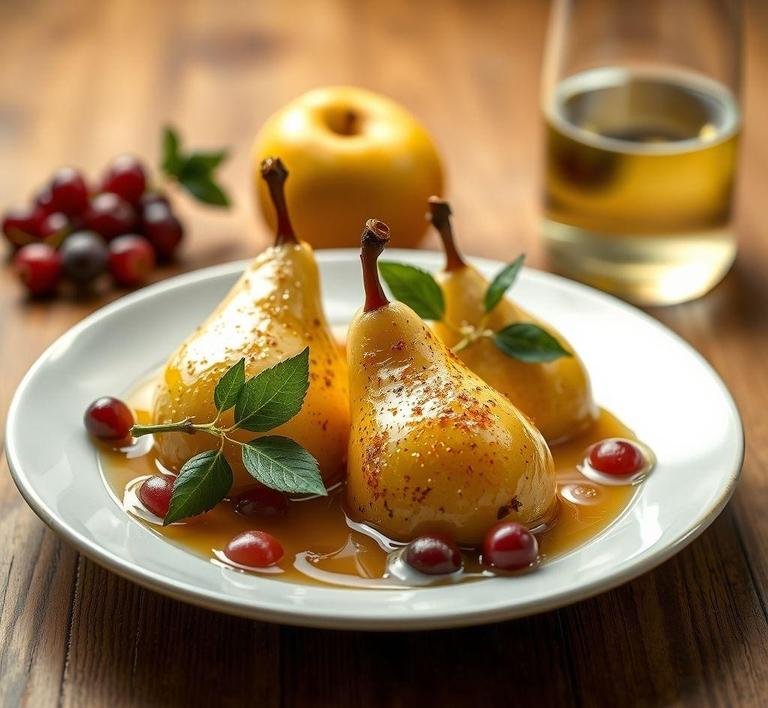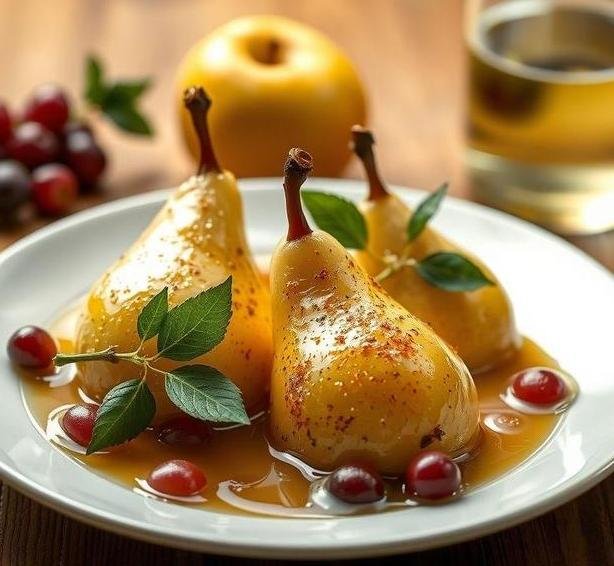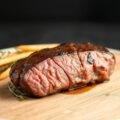Mary Berry’s Pears in White Wine is a sophisticated and elegant dessert that combines the sweet, delicate flavor of pears with the subtle, aromatic notes of white wine. Known for her culinary mastery, Mary Berry has a knack for transforming simple ingredients into gourmet dishes, and this dessert is no exception. The pears are poached gently in a flavorful mixture of white wine, sugar, and spices, which allows them to absorb the wine’s richness while becoming tender and aromatic. It’s a dish that exudes refinement while being relatively easy to make, making it an ideal choice for dinner parties, special occasions, or a cozy evening treat. The natural sweetness of the pears is enhanced by the wine, and the infusion of spices such as cinnamon and vanilla elevates the overall experience, creating a delicate balance of flavors that are both refreshing and indulgent. The recipe typically calls for white wine, but you can adjust the flavor profile by experimenting with different varieties of wine, such as a crisp Sauvignon Blanc or a slightly sweeter Riesling.
Mary Berry’s Pears In White Wine Recipe
Ingredients Needed

To recreate this elegant dessert, you’ll need the following ingredients:
- Pears (4-6, depending on size) – The main ingredient, ripe but firm pears work best as they will hold their shape during poaching while softening to a luscious texture.
- White Wine (750 ml) – A bottle of dry white wine such as Sauvignon Blanc, Chardonnay, or Riesling. The wine imparts a fruity, slightly tangy flavor to the pears.
- Sugar (200g) – Granulated sugar is typically used to sweeten the poaching liquid. It helps balance the acidity of the wine and enhances the pear’s natural sweetness.
- Lemon Juice (1 tablespoon) – Fresh lemon juice adds a hint of citrus to brighten the dish and prevent the pears from browning while they cook.
- Cinnamon Stick (1 or 2) – A whole cinnamon stick adds a warm, spicy fragrance to the poaching liquid, making the dessert more aromatic and comforting.
- Vanilla Pod (1) – For an added layer of depth, a vanilla pod is split and scraped to release its seeds, infusing the wine and pears with a delicate, sweet fragrance.
- Cloves (2-3) – A couple of cloves add an extra layer of warmth and complexity to the poaching syrup.
- A Pinch of Salt – This balances the sweetness and spices, rounding out the flavor profile.
Optional:
- Whipped Cream or Mascarpone – For serving, these can add a creamy, indulgent contrast to the fruity pears.
- Chopped Pistachios or Hazelnuts – If you want a crunchy element, chopped nuts can make a delightful garnish.
Equipment Needed
You don’t need anything too fancy to prepare Mary Berry’s Pears in White Wine, but there are a few essential items that will make the process smoother:
- Medium to Large Pot – A sturdy pot or Dutch oven is ideal for poaching the pears. It should be large enough to hold the pears upright in the poaching liquid without overcrowding them.
- Sharp Knife and Peeler – For peeling the pears and removing the cores, a sharp knife is a must.
- Peeler (optional) – If you prefer to peel the pears with ease, a good vegetable peeler will be your best friend.
- Strainer or Fine Mesh Sieve – After the pears are poached, you’ll need to strain the liquid to remove the whole spices and any impurities.
- Serving Plates or Bowls – Elegant plates or bowls will help present the dish in a visually appealing way, especially if you plan to serve it as part of a special meal.
Instructions To Make Mary Berry’s Pears In White Wine
Making Mary Berry’s Pears in White Wine is a simple yet satisfying process. Here’s a step-by-step guide to creating this delicious dessert:
- Prepare the Pears: Begin by peeling the pears, leaving the stems intact for a more elegant presentation. Cut them in half and remove the cores using a melon baller or small spoon. You can also use a paring knife to cut out the cores if you don’t have a melon baller.
- Create the Poaching Liquid: In a large pot, pour the white wine and add the sugar, lemon juice, cinnamon stick, vanilla pod (split and scraped), and cloves. Bring the mixture to a gentle simmer over medium heat, stirring to dissolve the sugar completely. Once the sugar is dissolved, allow the mixture to come to a low simmer.
- Poach the Pears: Carefully add the pear halves to the simmering wine mixture. Make sure the pears are submerged in the liquid, adding a bit more wine or water if necessary. Lower the heat to a gentle simmer and let the pears cook for about 25-30 minutes, depending on their size and ripeness. The pears should become tender but not mushy, so check them occasionally by piercing the thickest part with a fork.
- Check for Doneness: Once the pears are tender, remove the pot from the heat and allow the pears to cool in the poaching liquid. This will help them absorb even more of the wine’s flavor.
- Strain the Poaching Liquid: After the pears have cooled, strain the poaching liquid into a clean pot or bowl, discarding the spices and any fruit remnants. If you prefer a thicker syrup, return the liquid to the pot and simmer it for a few more minutes to reduce it until it reaches a syrupy consistency.
- Serve: To serve, place the poached pear halves in individual bowls or on serving plates. Spoon over some of the reduced poaching syrup and, if desired, add a dollop of whipped cream, mascarpone, or a sprinkle of chopped nuts for added texture and richness.
Tips And Tricks
- Choose the Right Pears: Select pears that are firm and ripe, like Bartlett, Bosc, or Conference. These varieties hold up well during poaching and won’t fall apart. Avoid overly ripe pears as they may become mushy when poached.
- Wine Selection: If you’re unsure which white wine to use, go for something dry but fruity. A Sauvignon Blanc or Chardonnay is an excellent choice, but you can experiment with a slightly sweeter wine like a Riesling for a different flavor profile.
- Infuse the Spices: Don’t be afraid to get creative with your spice choices! Try adding star anise or a strip of orange peel to give the dish a unique twist. Just be sure to keep the spices balanced so that they don’t overpower the pears and wine.
- Make Ahead: This dessert can be made ahead of time and stored in the fridge for up to 3 days. The flavors only get better as they marinate in the poaching liquid, making it perfect for prepping ahead of dinner parties or busy weeks.
- Serving Suggestions: Mary Berry’s Pears in White Wine pairs beautifully with a variety of desserts. Serve with a side of lightly sweetened whipped cream, mascarpone, or even a scoop of vanilla ice cream. A sprinkle of crushed nuts like pistachios or hazelnuts can add a lovely crunch to the soft, tender pears.
Mary Berry’s Pears in White Wine is an elegant and refined dessert that combines the delicate sweetness of poached pears with the complexity of white wine and spices. With its simple yet sophisticated flavors, it makes for a perfect finale to any meal, whether it’s a casual family dinner or a fancy dinner party. The beauty of this dish lies in its versatility-it’s not only easy to make, but it also allows for customization based on your wine and spice preferences. The poaching process ensures that the pears remain tender while absorbing all the flavors from the wine, sugar, and spices. Serve it with whipped cream or mascarpone for an indulgent finish, and you’ve got a dessert that’s sure to impress. This dessert embodies the charm of Mary Berry’s style: classic, comforting, and utterly delicious.
Easy Recipe Variations For Mary Berry’s Pears In White Wine

Mary Berry’s Pears in White Wine is a timeless dessert that’s both sophisticated and simple, offering a beautiful balance of sweetness and acidity. But like any beloved recipe, it’s versatile and can be easily adapted to suit a variety of tastes and occasions. Here are some easy and delightful variations to consider:
1. Pears In White Wine With Spices
A subtle spice infusion can elevate the depth of the pear’s natural sweetness. Adding a stick of cinnamon, a few whole cloves, or a couple of star anise to the white wine as it simmers can bring a warm, comforting note. These spices complement the pear’s gentle flavor, especially during colder months. For a more exotic twist, a pinch of ground ginger or nutmeg can work wonders.
2. Pears In White Wine With Citrus Zest
For a fresh and zesty upgrade, incorporate strips of lemon or orange zest into the simmering liquid. The citrus oils and fresh scent that infuse the pears will brighten up the dish, creating a refreshing contrast with the richness of the wine and the soft, tender pears. This variation is particularly popular during the warmer months when a light, fresh twist can be really appealing.
3. Pears In White Wine With Honey And Vanilla
If you want to add an extra layer of sweetness without overloading the dish, a few tablespoons of honey can be gently stirred into the wine. Honey’s smooth, floral undertones add an extra dimension that pairs wonderfully with pears. Pair this with a vanilla pod for an indulgent, aromatic finish. The warm scent of vanilla enhances the dish’s comforting nature, making it perfect for holiday dinners or special occasions.
4. Pears In White Wine With Berries
For a more vibrant and colorful variation, adding berries can really transform the presentation and flavor. Consider folding in raspberries, blackberries, or even blueberries towards the end of cooking, allowing them to soften in the white wine. Their tartness cuts through the sweetness of the pears and wine, creating a balanced and complex dish that appeals to those who like a little more tang.
5. Pears In White Wine With Crumbled Shortbread
For a bit of texture, you can make a crumbly topping by crumbling shortbread biscuits into the serving dish or over the pears once they’re plated. The buttery crunch complements the soft pears and wine sauce, adding a contrast that takes the dessert to the next level. This variation is especially great for those who enjoy a mix of textures in their dessert.
Each of these variations offers a unique twist on Mary Berry’s classic recipe, allowing you to play with flavors and textures to suit different preferences and seasons. Whether you’re looking for something more warming with spices, or a light, fruity touch with citrus or berries, these adaptations ensure that Mary Berry’s Pears in White Wine remains a versatile and timeless dish.
Storing Leftovers
When it comes to storing leftover pears in white wine, it’s important to preserve both the delicate fruit and the aromatic, flavorful wine sauce. Here’s how you can do it properly to ensure it lasts for a few days while maintaining its flavor:
Refrigeration
Place any leftover pears in an airtight container or a tightly sealed jar, making sure the pears are fully submerged in the white wine syrup. This will prevent the pears from drying out and help the wine continue to infuse its sweetness into the fruit. Refrigerate them immediately after the dish has cooled down to room temperature.
Shelf Life
Pears in white wine can typically be stored in the refrigerator for about 2 to 3 days. While the pears may soften a little further as they sit, the flavor will continue to develop, often becoming even richer and more complex after a day or two. However, for the best texture and freshness, it’s recommended to consume them within 1 to 2 days.
Freezing (Optional)
If you have a large batch of leftovers or want to prepare ahead, freezing is an option-though keep in mind that the texture of the pears may change slightly after thawing. To freeze, place the pears and their wine sauce in a freezer-safe container, leaving a little room for expansion. Freeze for up to 2 to 3 months. When ready to eat, thaw in the refrigerator overnight. While the pears might not retain the exact same firmness, the dish will still be delicious, and the sauce will taste just as lovely.
Reheating
To reheat your leftover pears, place them in a saucepan over low heat, allowing them to warm through gently. If the wine sauce has thickened too much in the fridge, you can add a little extra wine or water to loosen it up. Avoid overheating the pears, as they can become mushy. Serve them slightly warm for the best experience.
What To Eat With Mary Berry’s Pears In White Wine?
Mary Berry’s Pears in White Wine is a delightful dessert that pairs beautifully with a variety of accompaniments. Whether you’re looking for something light, savory, or indulgent to complement the pears, here are some ideas to elevate your meal:
1. Fresh Cream Or Whipped Cream
A classic pairing, the creamy richness of fresh cream or a dollop of softly whipped cream enhances the subtle sweetness of the pears. The richness contrasts with the fruity, floral flavors of the white wine syrup, making for a perfectly balanced dessert. For an extra touch, consider adding a splash of vanilla extract to the whipped cream.
2. Mascarpone Or Ricotta
For a more indulgent twist, serving the pears with a dollop of mascarpone or ricotta cheese creates a delightful contrast. The creamy, slightly tangy texture of the cheese complements the sweetness of the pears and the aromatic wine sauce. You can even add a drizzle of honey or a sprinkle of cinnamon on top for an added layer of flavor.
3. Almond Biscotti
For something crunchy, a few pieces of almond biscotti served alongside the pears adds a wonderful textural contrast. The nutty, slightly sweet biscotti enhances the overall flavor profile of the dish, and it also gives a little bite against the soft pears and smooth wine sauce.
4. Cheese Plate
If you’re hosting a more savory or cheese-centric meal, pears in white wine pair wonderfully with soft, creamy cheeses such as brie, camembert, or goat cheese. The creaminess of these cheeses balances the sweetness of the pears, while the wine sauce adds complexity to the pairing. A few slices of a rich, tangy cheese will create a perfect end to a sophisticated meal.
5. Light, Citrusy Salad
If you want to balance the richness of the pears with something fresh and zesty, a light citrus salad works beautifully. The acidity of oranges, grapefruits, or even a tangy vinaigrette contrasts nicely with the sweet and soft pears. The freshness of the salad will cleanse the palate and leave you feeling refreshed after the dessert.
6. Poached Or Roasted Nuts
For a bit of added crunch and flavor, poached or roasted nuts such as pistachios, almonds, or hazelnuts bring both texture and depth to the dish. Their slightly salty profile complements the sweetness of the pears and wine, adding an elegant touch that pairs well with any wine-based dessert.
These accompaniments will complement the delicate flavors of Mary Berry’s Pears in White Wine, creating a well-rounded and memorable dessert experience. Whether you prefer something creamy, crunchy, or fresh, there’s a perfect pairing waiting for you.
Conclusion
Mary Berry’s Pears in White Wine is an exquisite dessert that has the perfect balance of elegance and simplicity. Its versatility allows it to be easily tailored to suit different preferences, whether by adding spices, citrus, or berries. Storing leftovers is simple, ensuring you can enjoy this delicious treat for a few days or even prepare it ahead of time by freezing it for future indulgence.
Pairing the pears with rich creams, tangy cheeses, or crunchy biscotti further enhances the dish’s appeal, making it a fantastic end to any meal. Whether you’re serving it as a cozy treat after a weekday dinner or as a showstopper for a special occasion, this dessert can always be adapted to fit the mood and setting.
Mary Berry’s Pears in White Wine is more than just a dessert; it’s an invitation to explore flavors, textures, and creative pairings. Simple yet sophisticated, it’s the kind of dish that brings people together and leaves a lasting impression on anyone lucky enough to enjoy it.
FAQs
What Are The Key Ingredients In Mary Berry’s Pears In White Wine Recipe?
The key ingredients for Mary Berry’s pears in white wine recipe include fresh pears (usually peeled and cored), white wine, sugar, lemon juice, and spices like cinnamon, cloves, or vanilla. Some variations also include orange zest or a splash of brandy, depending on personal preference.
How Long Should I Cook The Pears In White Wine For The Best Texture?
The pears should be simmered gently in the white wine for about 20 to 30 minutes. This allows them to soften and absorb the flavors without becoming mushy. The cooking time can vary slightly depending on the size and ripeness of the pears, so it’s best to check for tenderness with a knife or fork before removing them from the liquid.
Can I Make Mary Berry’s Pears In White Wine Ahead Of Time?
Yes, you can definitely make Mary Berry’s pears in white wine ahead of time. In fact, the dish often tastes even better after it has had some time to sit, as the pears soak up more of the wine and spices. Store the cooked pears in the refrigerator for up to 3 days. You can reheat them gently on the stove or serve them cold, depending on your preference.


